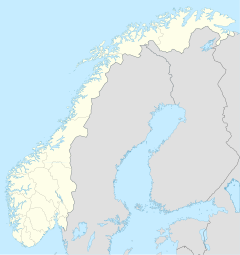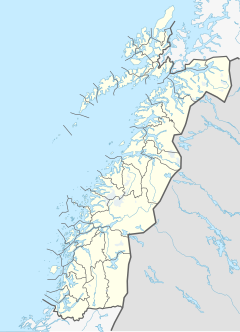Andøya Space, also named Andøya Space Center and formerly Andøya Rocket Range, is a rocket launch site, rocket range, and spaceport on Andøya island (the northernmost in the Vesterålen archipelago) in Andøy Municipality in Nordland county, Norway. Since 1962, over 1,200 sounding and sub-orbital rockets of various configurations have been launched from the site.
 | |
| Agency overview | |
|---|---|
| Abbreviation | ASC |
| Formed | 1962 |
| Type | Space agency |
| Owner | Royal Norwegian Ministry of Trade and Industry and Kongsberg Defence & Aerospace |
| Employees | 100 |
| Website | http://andoyaspace.no |
Andøya Space is a civilian, limited liability company with its ownership split between two groups: 90% by the Royal Norwegian Ministry of Trade and Industry, and 10% by Kongsberg Defence Systems company.[1] It operates on a commercial basis. Andøya Space also supports the SvalRak launch facility in Ny-Ålesund, Svalbard to the north. The facility has provided operations for both ESA, NASA, JAXA and DLR missions and related scientific research.
History
editThis section needs expansion with: Andoya rocket range history prior to the establishment of the 2nd rocket range in 1997. You can help by adding to it. (April 2018) |
Ferdinand 1
editOn August 18, 1962, the rocket that was to take Norway into the space age, Ferdinand 1, launched from Andøya Rocket Range. This happened only five years after the Soviet Union launched the first man-made satellite, Sputnik 1.
The Norwegian scientists named the rocket "Ferdinand" after the story of the peaceful bull that did not like to fight but would rather sit in the meadow smelling the flowers. The name was appropriate since the area of the Rocket Range was called Oksebåsen, "The Ox Pasture". This was during the Cold War, so the name should also indicate that Andøya Rocket Range only had peaceful intentions with its research.
Ferdinand-1 was a NIKE-Cajun two-stage rocket that carried two instruments in its payload. The purpose of the launch was to do measurements in the ionosphere, where charged particles from the Sun ionize the atoms. The process is most intense in the polar ionosphere, and is important not only for the Northern Lights, but also for long-range radio communication, because the free electrons reflect the radio waves. The goal was to explore the possibility of improving long-range radio communication.
The rocket was 7.7 m long, had a total weight of 698 kg and a maximum speed of 6760 km/h. It reached a height of 102 km into the atmosphere. Launching and collecting data after the first rocket was considered a success. Ferdinand 1 became the first of many successful rocket launches from Andøya.[2]
Svalbard Rocket Range
editIn 1997, a second launch site—Svalbard Rocket Range—was established at Ny-Ålesund, Svalbard, enabling scientists to launch sounding rockets straight in the polar cusp, where the Earth's magnetic field lines converge.
A ground-based, lidar observatory, ALOMAR (Arctic Lidar Observatory for Middle Atmosphere Research) opened in 1994, and is considered[by whom?] unique in atmospheric research in the Arctic. The range is also host of northern Europe's largest VHF-radar.[3]
In 1995, a Black Brant sounding rocket launched from Andøya caused a high alert in Russia, known as the Norwegian Rocket Incident.[4] The Russians thought it might be a nuclear missile launched from an American submarine. President Boris Yeltsin was alerted for a possible counter strike, when the Russians understood that it was not heading towards Russia. Russia was informed in advance about the launch, but this information was lost in the Russian bureaucracy, and never reached the radar operators; only seafarers were notified.[5]
The space center changed its name from Andøya Rocket Range on 6 June 2014 to reflect an increased focus on also other activities than sounding rockets, though rocketry is still its main focus.[citation needed] Other activities are UAVs, lidar and radar measurements for atmospheric research and also a test center for missiles through its subsidiary Andøya Test Center.
Orbital Launch Plans
editAndøya has been proposed as a spaceport for launching orbital Nanosatellite launch vehicles (NLVs).
North Star
editIn January 2013, the Nammo company and the Andøya Space Center announced that they would be "developing a rocket system called North Star that will use a standardized hybrid motor, clustered in different numbers and arrangements, to build two types of sounding rockets and an orbital launcher" that would be able to deliver a 10 kg (22 lb) nanosat into polar orbit.[6][needs update]
Andøya Spaceport
editAndøya Spaceport was established as a project in 2018,[7] with the aim of establishing the first European launch base for small satellites. It is mainly satellites for Earth observation and communications that are planned to be launched from Andøya, in polar- or Sun-synchronous orbit. In polar orbit, the satellite passes above or near the Earth's poles at each orbit. This is favorable for Norway as they then provide good satellite coverage of Norwegian areas, good communication and sea monitoring in the north. Sun-synchronous orbit means that the satellite passes a given latitude to two fixed local times, one for northbound and one for southbound passage. The satellite's orbital plane rotates eastwards approx. 1 degree per day, and so it maintains the angle with respect to the sunlight and gets most light for its solar cells. In this way, satellites for Earth observation receive data with an equal amount of sunlight and can thus use data to analyze changes that occur on the surface throughout the year. Norway funded the site with NOK 365.6 million, expecting a commercial return of the investment.[8]
Commercial Partnerships
edit2020-Present
editIsar Aerospace
editIsar Aerospace of Germany signed an agreement with Andøya Space, securing exclusive access for a period of up to twenty years to one launch pad on the island Andøya. As a launch site operator, the Andøya Spaceport provides launch pads, payload integration facilities as well as the technical infrastructure on site. [9]
Ingun Berget, President of Andøya Spaceport said: “The opening of the spaceport on Andøya island marks an important milestone for Norway, European New Space industry and our partnership with Isar Aerospace: This enables us to have the first satellite launches ever from European soil to take place from Andøya. The attendance of today's opening by Crown Prince Haakon underlines the importance of our endeavor and puts us on the New Space map in Europe.” [10]
Daniel Metzler, CEO and Co-Founder of Isar Aerospace said: “Today, Norway, the Andøya region and Isar Aerospace take a big step towards space. Over the last five years, we have built a rocket that will help to solve the most crucial bottleneck in the European space industry – sovereign and competitive access to space. Together with Andøya Spaceport, our team has created an excellent piece of engineering, the first orbital launch site in continental Europe which will bring this access to space to Norway, and back to Europe. For Isar Aerospace, this step equals entering the final stages of our path to first flight. For Europe, it means being able to harness the power of the space platform.” [10]
Pads
editAndøya has six launch pads during all or part of its life as a launch site:[citation needed]
- LC5 69°17′40″N 16°01′11″E / 69.2944°N 16.0198°E
- LC9 69°17′39″N 16°01′08″E / 69.2941°N 16.0188°E
- LC10[when?] 69°17′38″N 16°01′07″E / 69.2940°N 16.0185°E
- Athena 69°17′39″N 16°01′15″E / 69.2943°N 16.0207°E
- Haugnes[when?] 69°16′48″N 16°10′48″E / 69.2800°N 16.1800°E
- U3 69°17′39″N 16°01′15″E / 69.2943°N 16.0207°E
- Orbital Launch Pad A 69°06′31″N 15°35′19″E / 69.1087°N 15.5887°E
References
edit- ^ "About ASC". Retrieved 13 March 2018.
- ^ Thrane, Eivind V. (2018-12-07). "The history of Andøya Rocket Range". History of Geo- and Space Sciences. 9 (2): 141–156. Bibcode:2018HGSS....9..141T. doi:10.5194/hgss-9-141-2018. ISSN 2190-5029.
- ^ V, THRANE E.; U, VON ZAHN (September 1995). "ALOMAR-A New Facility for Middle Atmosphere Research at Arctic Latitudes". Journal of Geomagnetism and Geoelectricity. 47 (9): 921–928. Bibcode:1995JGG....47..921T. doi:10.5636/jgg.47.921.
- ^ Budalen, Andreas; Dan Henrik Klausen (February 26, 2012). "Verden har aldri vært nærmere atomkrig". Norwegian Broadcasting Corporation. Retrieved May 12, 2012.
- ^ Pry, Peter (1999). "Black Brant XII". War scare: Russia and America on the nuclear brink. New York: Praeger. pp. 214–227. ISBN 0-275-96643-7.
- ^ Lindsey, Clark (2013-01-28). "North Star rocket family with hybrid propulsion". NewSpace Watch. Archived from the original on 2013-06-20. Retrieved 2013-01-28.
- ^ fiskeridepartementet, Nærings-og (2019-12-13). "Meld. St. 10 (2019–2020)". Regjeringen.no (in Norwegian). Retrieved 2020-03-12.
- ^ "Grønt lys for satellittoppskyting fra Andøya". Tu.no (in Norwegian). Teknisk Ukeblad. 8 October 2021.
- ^ "Launch site secured: Isar Aerospace signs exclusive launch pad in Norway for up to 20 years". Isar Aerospace. Retrieved 2024-05-22.
- ^ a b "Andøya Spaceport, future launch site of Isar Aerospace, opened in official ceremony with Crown Prince Haakon of Norway". Isar Aerospace. Retrieved 2024-05-22.

